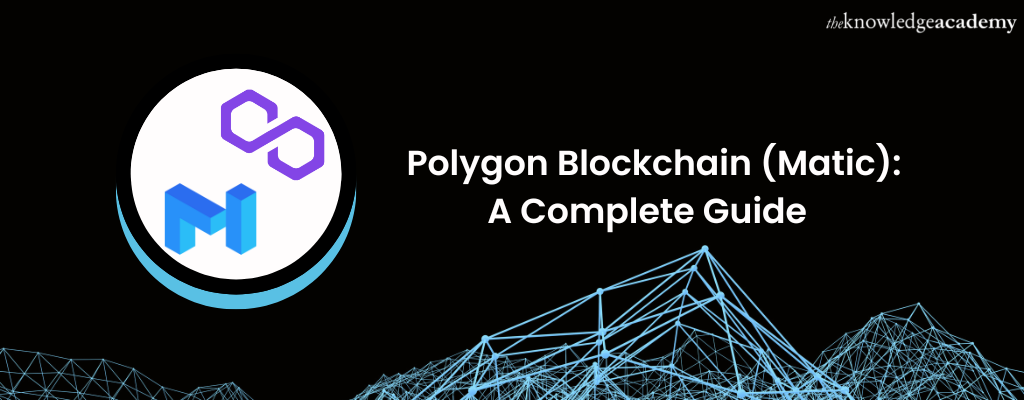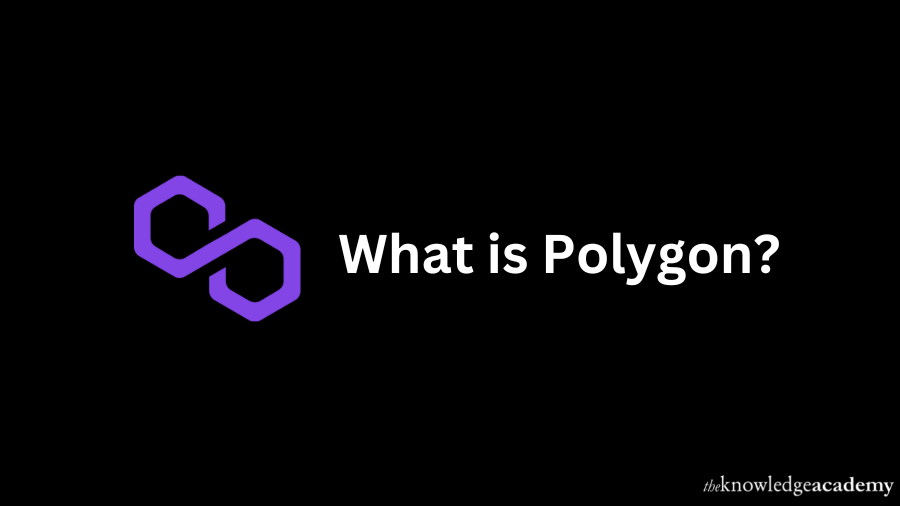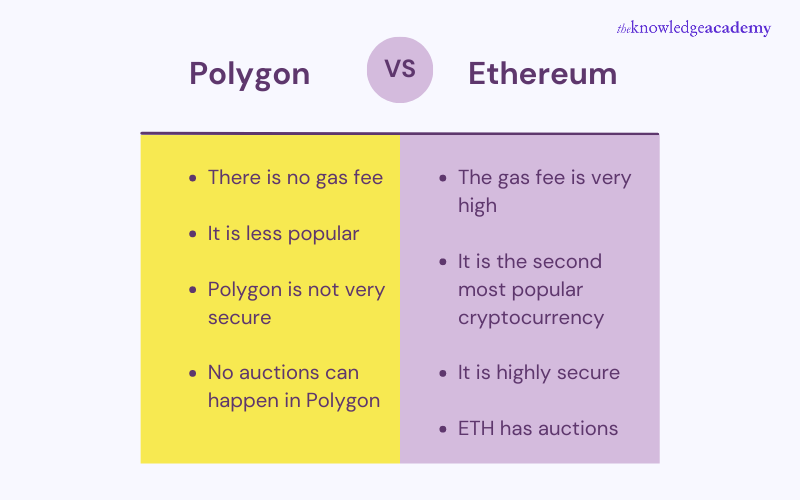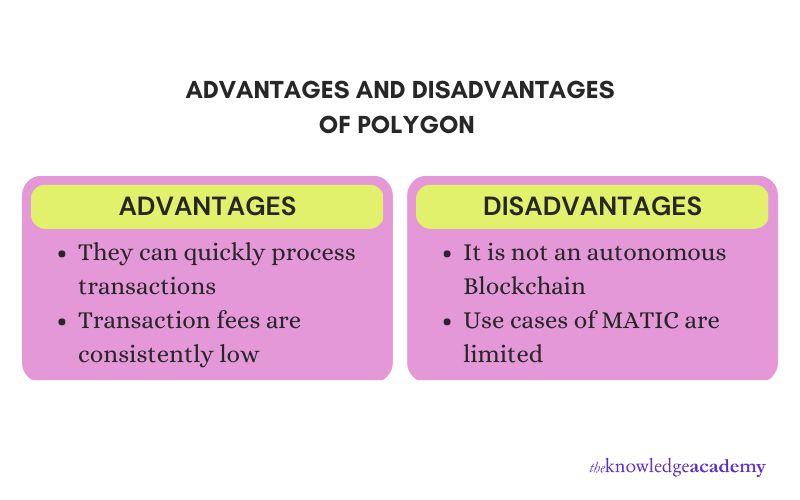We may not have the course you’re looking for. If you enquire or give us a call on 01344203999 and speak to our training experts, we may still be able to help with your training requirements.
Training Outcomes Within Your Budget!
We ensure quality, budget-alignment, and timely delivery by our expert instructors.

Polygon Blockchain (MATIC) is a ‘Layer 2’ or ‘Sidechain’ solution that focuses on solving the scalability-related issues of the Ethereum (ETH) Blockchain. Scalability has been one of the core issues with the Ethereum platform. As a result, its functionality and effectiveness get affected significantly. The number of people using Ethereum since its launch in 2015 has increased considerably, due to which the Blockchain network is facing several capacity limitations.
Polygon - powered by Ethereum tokens, is a protocol and framework that builds and connects Blockchain networks compatible with Ethereum. This protocol is aimed at faster and cheaper Ethereum transactions. According to CoinMarketCap, it can support more than 65,000 transactions per second on a single side chain on the Blockchain network, thereby extending significant speed and ease to all Ethereum-based transactions.
Table of Contents
1) What is Polygon?
2) What is MATIC?
3) How does Polygon Work?
4) Who is behind Polygon?
5) What differentiates Polygon from MATIC?
6) What makes Polygon so special?
7) Why is Polygon good for Ethereum?
8) Polygon vs Ethereum
9) What is a Polygon wallet?
10) How to acquire a Polygon Wallet address?
11) Is Polygon a good investment?
12) How to invest in the Polygon cryptocurrency
13) Advantages and Disadvantages of Polygon
14) Future of Polygon
15) Conclusion
Join Blockchain Training Course to learn technological concepts of Cryptography and Bitcoin.
What is Polygon?

Polygon is the world’s first well-structured and easy-to-use platform used for scaling Ethereum and developing its related infrastructure. It transforms ETH into a multi-chain system, just like Polkadot, Avalanche, Cosmos, and others. Polygon crypto is a more effective form of cryptocurrency because it takes full advantage of ETH’s security, openness, and vibrant ecosystem. This helps it in supporting several applications on the ETH blockchain. It is expected that the $MATIC token will continue to play a vital role in the future, securing the Blockchain and enabling effective governance in the network.
It was co-founded in 2017 by Jayanti Kanani, Sandeep Naliwal, and Anurag Arjun and was known as the Matic Network. It regularly ranks among the top 15 cryptocurrencies. Today, MATIC provides support to 7000+ decentralised applications (dApps).
This Blockchain uses a modified version of the Proof-of-Stake (PoS) consensus method where every block on the network needs to give consensus. In the proof-of-stake method, the participants have to stake their MATIC, a symbol for the token traded on the Blockchain, in exchange for the right to validate transactions on the network. Staking is the process where the participants agree that they will not trade their MATIC but just use it to validate the transactions. MATIC tokens are rewarded to users for every successful validation in the network.
As a secondary scaling solution, the primary aim of Polygon is to address the limitations of Ethereum Blockchain, such as high transaction fees and slow transaction speeds. The focus of the Polygon project is on determining ways to reduce the complexity related to scalability. The Sidechains of this Blockchain are designed to support several different Decentralised Finance (DeFi) protocols present in the ETH Blockchain system. Today there are almost Five Billion Polygon coins in circulation, while the maximum supply of Polygon is limited to Ten Billion.
Learn to use managed Blockchain networks quickly using AWS CLI and AWS Management Console. Join Amazon Managed Blockchain Training course – today!
What is MATIC?
Matic is a Polygon-native cryptocurrency that is used to pay fees on the Polygon Network. It can be used for purposes of staking and governance, which suggests that MATIC holders have the right to vote on favoured changes to Polygon. MATIC can be bought and sold via Coinbase and other exchanges.
One interesting fact about the cryptocurrency is that it was originally launched as Matic Network in 2017. It was later rebranded as Polygon in early 2021.
How does Polygon Work?
The Polygon platform builds an interconnected network of Blockchains. It uses Sidechaining to resolve the scalability issue and runs parallel to the Mainchain architecture of ETH. Whenever required, assets are transferred to the Sidechain from the Mainchain. For such a transfer, Plasma chains are used in the Polygon network.
The Mainchain of Polygon is a Sidechain that uses the PoS approach to determine which user can validate or mine a block. This is opposite to the Proof-of-Work (PoW) approach, where every node in the Blockchain network has to attempt to solve a complex mathematical problem. In the PoW approach, miners with the most expensive hardware win. However, this is different with ETH Blockchain-powered Polygon.
Polygon uses the Heimdall architecture for randomly selecting the Block producers. It also helps in ensuring the security and scalability of the network. The Polygon validators run parallel to ETH’s Mainchain and regularly validate all its transactions. This way, consistency is maintained in the network.
Want to become familiar with Cryptocurrency trading and Blockchain technology? Join Cryptocurrency Trading Training course.
Who is behind Polygon?
The strong reputation of Polygon as the most valuable Ethereum scalability project is a result of its versatile and hardworking development team. It is safe to say that the consistent and increasing growth of Polygon has been possible greatly because of the efforts of the team.
The success of the MATIC network is a testament to the talents of its creators, who could foresee the upcoming trends of the crypto industry. Let us learn more about these futuristic creators.
The three founders of Polygon
Polygon was created by three individuals - Jaynti Kanani (current CEO of Polygon), Sandeep Nailwal (Co-founder and Chief Operating Officer), and, Anurag Arjun (Co-founder and Chief Product Officer), in 2017.
Although Polygon was conceived in India, its popularity peaked all around the globe, attracting investors from every corner. Over £3,68,604 was raised within just two rounds of startup funding in 2019.
Refer to these Blockchain Interview Questions and Answers to crack your next job interview!
What differentiates Polygon from MATIC?
Even though Polygon and MATIC are used interchangeably, they have several points of difference. While Polygon is a Layer-2 scaling infrastructure existing on the Ethereum Blockchain, MATIC is its native token used to power the Blockchain ecosystem. At the time of its launch in 2019, Polygon was named Matic Network and offered Plasma chains, which are very similar to the Sidechains. These Plasma chains provided better security for running various highly complex operations. However, in 2021 the project adopted Sidechains and Matic Network was rebranded as Polygon. After the rebranding was completed, Polygon’s founders decided to retain the name MATIC for its native utility crypto token.
Polygon expands the scope of the MATIC platform to allow for the Ethereum network to increase by integrating other scaling solutions such as zkRollups, Optimistic Rollups, and others.
Through MATIC, the success of Polygon will mean Ethereum can become a multi-chain system with advanced security features and flexible scaling solutions. It will also provide benefits of ETH’s vast network and openness. After the name change and rebranding, Polygon is the umbrella name for various projects, including the Matic network.
Learn how Bitcoins work and how are Bitcoins made secured by joining Bitcoin and Cryptocurrency Course.
What makes Polygon so special?
It has been established by now that there are a variety of reasons why Polygon stands apart from its other layer 2 competitors. Here are four of the main reasons why Polygon is considered special.
a) One of the distinctive features of Polygon is the fact that it allows MATIC (Polygon’s cryptocurrency) to be staked on its Blockchain, and it is the only network that permits this.
b) Polygon was not made to satisfy their developers alone. It provides solutions for everyone including users and enterprises alike. The ultimate aim is to scale Ethereum to one billion users without compromising security. This is preceded by their goal of creating an Internet of Things (IoT) for the Ethereum blockchain.
c) Another special feature is the liberty of the developer to choose between zkrollups or optimistic rollups. Another potential choice of a secure data availability Blockchain is the Polygon Avail.
d) Polygon provides a range of solutions on a single network for developers. This allows them to make better choices regarding the scaling solution for their application.
Why is Polygon good for Ethereum?
The most crucial point that people usually miss out on when it comes to Polygon and Ethereum is that they are interdependent. Polygon’s mission is to develop infrastructure and systems that can effectively manage the mass adoption of Ethereum through Polygon’s network. This points to the fact that Polygon is more dependent on Ethereum than the other way around.
Since Polygon improves Ethereum, the number of users of the Ethereum Blockchain will grow in numbers. A rise in value is noticed as more and more users invest their capital in the Ethereum blockchain.
Polygon vs. Ethereum

ETH is a prime example of slow and expensive Blockchains. ETH promotes decentralisation and security but fails to scale and provide users with a fast and cheap experience. Individuals must pay ‘Gas fees’ to operate on the Blockchain networks. However, when the networks reach their capacity, this fee increases significantly. But this is not the case with using Polygons, as these networks rely on a Plasma chain which runs parallel to Ethereum. This reduces the Gas fees and also increases the transaction speed significantly. The Gas fee on Polygon is much less than that of ETH.
More than 70% of people who use Non-Fungible Tokens (NFTs) have heard of and utilised ETH, but this differs from the rest of the NFT users. This shows Polygon is less popular than Ethereum. Due to this, using Polygon for the first time can be challenging for novice and non-technical users because they might know ways to bridge ETH to Polygon.
Polygons are less secure than ETH because they are centralised. If a hacker manages to gain access to the system, they might also be able to access the Polygons. This compromises the security of the Blockchain network.
Users can auction only the ETH Blockchains. This feature is not available in Polygons as it is currently working on building the auctions feature on its systems. Users can perform auctions on ETH Blockchains instead of just listing them for a fixed price.
What is a Polygon wallet?
A Polygon wallet is one of the tools that allow users to navigate through the Polygon network with ease. It helps users with sending and receiving crypto assets alongside depositing and withdrawing between Blockchains by providing access to the Polygon bridge. Apart from this, the Polygon wallet helps stake MATIC on its network.
One of the advantages of being linked with the Polygon network is the non-custodial web wallets it provides. The web wallets help in managing your tokens within the network and hands over exclusive control over the private keys, to the user. Although, MATIC can be held by any ERC-20-compatible wallet.
How to acquire a Polygon wallet address?
You can acquire a Polygon wallet address through a few easy steps. Users can choose the Polygon wallet in which they wish to store their MATIC tokens, after purchasing it. This is easy, because Polygon allows a direct transfer of the MATIC tokens to any Polygon wallet address, after being purchased. A few of the well-known web wallets for Polygon include MetaMask, Ledger, Celsius, and Nexo.
Is Polygon a good investment?
As established before, Polygon does improve Ethereum. It is the largest Blockchain network and its currency – Ether (ETH) - being the second-largest cryptocurrency in the world, is undeniably a great network to flourish in. The reputation of Ethereum proves the massive potential of growth for Polygon, thereby making it a good investment.
How to invest in the Polygon cryptocurrency
Coinbase and Binance are examples of a few cryptocurrency exchanges that help you purchase MATIC. The only extra steps to follow is creating an account before finding the MATIC tokens and completing the purchase.
Decentralized Exchanges (DEXs) like Uniswap can also be used to buy MATIC, if you are not a beginner in the cryptocurrency sector.
Advantages and Disadvantages of Polygon

Polygon was developed as a tool for resolving the scalability-related issues of ETH. It provides extensive support to Ethereum, attracting the interest of investors. There are many pros and cons of Polygons, as discussed below.
Advantages
They can quickly process transactions – Transaction speeds in a Polygon network are breakneck. The average speed of Polygon’s processing time is 2.1 seconds.
Transaction fees are consistently low – To use the platform, users must pay around £0.008. Such a low transaction fee makes it an attractive chain for DeFi apps.
Disadvantages
It is not an autonomous Blockchain – The Polygon runs on the Ethereum platform, and if there is any disruption in the platform, then the value of the Polygon will get affected.
Use cases of MATIC are limited – The purpose of MATIC tokens is to secure and govern the Blockchain and speed up the transaction process. Consequently, the use cases of MATIC are minimal.
Future of Polygon
With the current growth rate of Polygon, its future seems secure. Recent additions like the Polygon Studios, in 2021 – a branch of Polygon – in centered around gaming and non-fungible tokens (NFTs). The success of Polygon Studios is a powerful factor that contribute to pushing Polygon to being the leading technology provider for decentralized gaming and NFTs.
Conclusion
The Blockchain network of Polygon is powered by Ethereum and aims to provide a cheaper, faster, and a better overall experience to Ethereum users. However, Polygon is more than just a scaling solution. It was created to resolve the scaling issues of ETH. With this blog, we hope you were able to understand what Polygon is, how it works, its pros and cons, and how it is different from MATIC and ETH.
Become an Ethereum developer by signing up for Ethereum Developer Training course.







 Top Rated Course
Top Rated Course




 If you wish to make any changes to your course, please
If you wish to make any changes to your course, please


